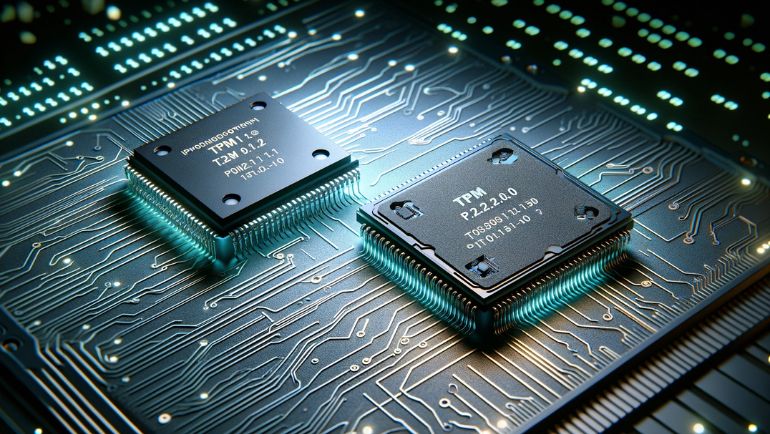
A Trusted Module Platform (TPM) is a microcontroller installed inside a motherboard to provide hardware-based encryption. However, some motherboard manufacturers have connectors to add TPM chips. Trusting Computing Group introduced two TPM versions, TPM 1.2 & TPM 2.0, for an additional layer of system security. Let’s look into the differences between TPM 1.2 vs TPM 2.0 to understand them better.
TPM 1.2 vs. TPM 2.0: A Detailed Comparison
The encryption key is stored and generated in the TPM chip, and the system can’t be unlocked without it. However, the level of encryption and performance might differ between TPM versions. The following section will highlight the differences between TPM 2.0 vs. TPM 1.2 in more detail.
TPM 1.2 vs. TPM 2.0: Security Features

TPM 1.2 has only one key for encrypting and decrypting systems; a single user is authorized to use it. In contrast, TPM 2.0 has multiple encryption keys and users, providing better security and control. The security models used in TPM 1.2 are older algorithms like RSA 2048b, while TPM 2.0 uses newer and more algorithms like RSA & ECC.
TPM 1.2 vs. TPM 2.0: Performance
When it comes to performance, TPM 2.0 is faster than TPM 1.2 as it has more processing power. Moreover, the advanced cryptographic algorithm and multiple-user control allow more efficient operations.
TPM 1.2 vs. TPM 2.0: Compatibility
Several compatibility issues may arise between TPM 1.2 vs. TPM 2.0. Modern motherboards only support TPM 2.0 today, while older motherboards may or may not have TPM 1.2. However, the new future standard for technologies like operating systems and hardware is TPM 2.0.
TPM 1.2 vs. TPM 2.0: Operating System Support
Both TPM 1.2 and TPM 2.0 support most operating systems, as tabulated below.
| Operating System | TPM 1.2 | TPM 2.0 |
| Windows 7 | Yes | No |
| Windows 8 | Yes | Yes |
| Windows 8.1 | Yes | Yes |
| Windows 10 | Yes | Yes |
| RHEL | Yes | Yes |
| Ubuntu | Yes | Yes |
TPM 1.2 vs. TPM 2.0: Root Keys & Algorithms
The algorithm differs in both TPM versions, enabling different functionalities and security features in the system.
| Algorithm Type | Name | TPM 1.2 | TPM 2.0 |
| Asymmetric | RSA 1024 | Yes | Optional |
| RSA 2048 | Yes | Yes | |
| ECC P256 | No | Yes | |
| ECC BN256 | No | Yes | |
| Symmetric | AES 128 | Optional | Yes |
| AES 256 | Optional | Optional | |
| Hash | SHA-1 | Yes | Yes |
| SHA-2 256 | No | Yes | |
| HMAC | SHA-1 | Yes | Yes |
| SHA-2 256 | No | Yes |
TPM 1.2 vs. TPM 2.0: Memory RAM
TPM operations rely on system memory for temporary storage and data processing during operations. Increasing the system’s memory can lead to faster performance and better user experience in both TPM versions.
TPM 1.2 vs. TPM 2.0: Pros and Cons
TPM 1.2 and TPM 2.0 complaint hardware encryptions have various pros and cons, some of which are as follows.
| TPM1.2 | Pros | Cons |
| Backward compatible | Limited functionality | |
| Simpler implementation | Less secure | |
| Lower Cost | Older Technology | |
| TPM 2.0 | Improved functionality | Limited compatibility |
| More secure | More complex implementation | |
| Future-proof | Higher cost |
TPM 1.2 vs. TPM 2.0: What to Choose?

The best TPM always depends on the compatibility of your system. TPM 2.0 has become the new standard, and TPM 1.2 is rapidly becoming obsolete. However, the older technologies only rely on TPM 1.2 for system protection as TPM 2.0 isn’t backward compatible. Computing Worlds offers a wide variety of new, used, and refurbished TPM modules for sale at the best price. Popular TPM 1.2 & TPM 2.0 for Sale:
You can also request a bulk quote online for the required networking devices.
Frequently Ask Questions:
Why is TPM important for consumers?
Trusted Platform Module (TPM)–hardware encryption—that protects consumers’ privacy by restricting unauthorized access.
Why is TPM 2.0 better than TPM 1.2?
TPM 2.0 has the latest algorithms and protocols that better protect your information and privacy than TPM 1.2.
Does Windows 11 require TPM 2.0?
Yes, windows 11 requires TPM 2.0 to work correctly.






